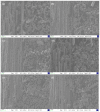Fabrication of Carbon Fiber Reinforced Aromatic Polyamide Composites and Their Thermal Conductivities with a h-BN Filler
- PMID: 33374700
- PMCID: PMC7793483
- DOI: 10.3390/polym13010021
Fabrication of Carbon Fiber Reinforced Aromatic Polyamide Composites and Their Thermal Conductivities with a h-BN Filler
Abstract
In this study, a carbon fiber-reinforced thermoplastic composite was fabricated using a new aromatic polyamide (APA) as a matrix. Non-isothermal crystallization behaviors in the cooling process of APA resin (a semi-crystalline polymer) and composite were analyzed by using a differential scanning calorimeter (DSC). To determine the optimum molding conditions, processing parameters such as the molding temperature and time were varied during compression molding of the Carbon/APA composite. The tensile and flexural properties and morphologies of the fabricated composites were analyzed. Molding at 270 °C and 50 MPa for 5 min. showed relatively good mechanical properties and morphologies; thus, this condition was selected as the optimal molding condition. In addition, to enhance the thermal conductivity of the Carbon/APA composite, a study was conducted to add hexagonal boron nitride (h-BN) as a filler. The surface of h-BN was oxidized to increase its miscibility in the resin, which resulted in better dispersity in the APA matrix. In conclusion, a Carbon/APA (h-BN) composite manufactured under optimal molding conditions with an APA resin containing surface-treated h-BN showed a thermal conductivity more than twice that of the case without h-BN.
Keywords: aromatic polyamide; boron nitride; carbon fiber; thermal conductivity; thermoplastic composite.
Conflict of interest statement
The authors declare no conflict of interest.
Figures















References
-
- Moon C.K., Ann C.H., Lee J.O., Cho H.H., Park J.M., Park T.W. Improvement of Mechanical Properties in Carbon Fiber Reinforced Thermoplastic Composites by Surface Modification. Polymers. 1993;17:644–653.
-
- Lee Y.S., Song S.A., Kim W.J., Kim S.S., Jung Y.S. Fabrication and Characterization of the Carbon Fiber Composite Sheets. Compos. Res. 2015;28:168–175. doi: 10.7234/composres.2015.28.4.168. - DOI
-
- Kim Y.A. Carbon Fiber Composite. Phys. High. Technol. 2003;12:31–35.
-
- Zushi H., Tamura M., Ohsawa I., Uzawa K., Takahashi J., Yasuda H. Evaluation on mechanical properties of carbon fiber reinforced polypropylene. J. Jpn. Compos. Mater. 2006;32:153–162. doi: 10.6089/jscm.32.153. - DOI
-
- Offringa A.R. Thermoplastic composites-rapid processing application. Compos. Part A Appl. Sci. Manuf. 1996;27:329–336. doi: 10.1016/1359-835X(95)00048-7. - DOI
LinkOut - more resources
Full Text Sources

